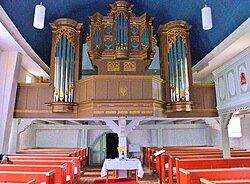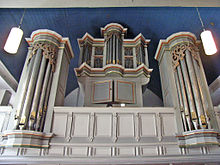Organ of St. Mauritius (Hollern)
| Organ of St. Mauritius (Hollern) | |
|---|---|

|
|
| General | |
| alternative name | Schnitger organ |
| place | St. Mauritius, Hollern |
| Organ builder | Arp Schnitger |
| Construction year | 1688-1690 |
| Last renovation / restoration | 2010/2011 Hendrik Ahrend |
| epoch | Baroque |
| Organ landscape | between Elbe and Weser |
| Technical specifications | |
| Number of registers | 24 |
| Number of rows of pipes | 35 |
| Number of manuals | 2 |
| Tone tract | Mechanically |
| Register action | Mechanically |
The organ of St. Mauritius ( Hollern ) was built by Arp Schnitger from 1688 to 1690 and has 24 stops on two manuals and a pedal . About half of the original pipe inventory and most of the case have been preserved.
Building history
Previous instrument
Dirck Hoyer from Hamburg , a journeyman of Hans Scherer the Elder , built a new organ with painted double doors on the old west gallery in 1575. In the invoice books from Hollern the wage, freight and material costs are listed in detail. The fact that Schnitger, contrary to his custom, did not take over any stops from the previous organ suggests that the instrument was in desolate condition at the end of the 17th century.
New building by Schnitger 1688–1690
After the old instrument had become quite susceptible to repairs, Arp Schnitger was commissioned to build a new organ in 1688. In 1690 the finished organ parts from Schnitger's workshop in Hamburg were shipped over the Elbe to Hollern. Schnitger's friend Vincent Lübeck accepted the new organ on September 21, 1691. The Stader Zimmermeister Andreas hen had built a second loft for the organ with a so-called organ editor ( "organ pulpit") so that the instrument reached to just below the church ceiling. The cramped space conditions can be read off the unusually short pipe feet in the pedal. According to Schnitger's postponed notes, the prospect whistles began with the low G, but actually with A.
The prospectus of the main plant is in five parts with an elevated polygonal central tower and two pointed towers on the outside. Two-storey flat fields, separated by narrow transom strips, mediate between the pipe towers. The pipes in the lower flat fields are mute. Two cymbal stars are attached above the flat fields . The prospectus pipes with a high lead content are original, laminated with a tin foil and have gold-plated round labia. At the top, the pipe fields are finished with sawn veil boards showing openwork tendrils. The narrow lateral blind wings were reconstructed according to old photos. The upper and lower cornice has gilded profile strips and a straight frieze . Segmented consoles lead over to the narrower lower housing.
Schnitger's new building had 24 stops on the main and breastworks and an independent pedal in two pedal towers in the gallery parapet. Due to the similarities in disposition , architecture and decor, the organ in Steinkirchen can be described as a sister instrument, but it has four more voices. Obviously, the Hollen parish had taken over financially with the new organ, because the payments had to be made in installments until 1695. Schnitger's disposition is handed down by Furtwängler in 1856:
Later work
Repairs are possible in 1756, 1766 and 1770 by Dietrich Christoph Gloger , but not secured. The situation is similar with a repair in 1776 by Georg Wilhelm Wilhelmy . Since the 1780s, a high gallery above the now abandoned gallery (“student choir”) for children and soldiers has been mentioned. A shortening of the organ case must therefore have taken place before 1780 and not until 1858.
The most serious reconstruction of the organ took place in 1858 by Philipp Furtwängler from Elze , who removed the breastwork in favor of a completely new rearwork. This new work comprised ten registers, from which the mixture from the main work was taken. Furtwängler also changed the disposition in the main work and pedal and replaced mixed voices with fundamental registers. It is usually assumed that the gallery was relocated immediately before Furtwängler's renovation.
In 1901, the organ editor was removed and the parapet straightened so that the pedal towers disappeared halfway behind the parapet. In 1959 the lower west gallery was removed and the organ gallery was lowered. As a result, the panels on the gallery balustrade were lost.
The organ building company Emanuel Kemper from Lübeck carried out another major renovation in 1965/1966. After the gallery was relocated, the pedal towers found their place in the gallery parapet, but were not given their original height. The action , the console and some of the wind chests of the main movement and pedal have been renewed . The lower case of the main movement was increased by about 110 cm to make room for a new breastwork. The two registers Sesquialtera and Scharff, most of which were made by Schnitger, returned to this breastwork. The entire pipe material has been reworked, even with the reed registers in the pedal that were originally preserved until then . The veil was partly removed without replacement.
restoration
Due to the incomplete restoration, the unsatisfactory proportioning of the overall system due to the shortened pedal housing and the interventions in the pipework, a consistent reconstruction to the original condition was carried out by Hendrik Ahrend in 2010/2011 . This included the restoration of the organ loft and the pedal towers. The previous tonal and technical deficiencies, which were compounded by inadequate maintenance measures since 1967, have now been remedied by the reconstruction of the non-original pipes, the breastwork wind chest and the mechanism. The preserved pipes and wind chests were restored and the original mid-tone mood was restored. The restoration / reconstruction of the color version was carried out by Dietrich Wellmer. The re-inauguration of the organ took place on August 28, 2011. The current disposition corresponds again to the status of 1690:
Disposition since 2011 (= 1690)
|
|
|
|||||||||||||||||||||||||||||||||||||||||||||||||||||||||||||||||||||||||||||||||
- Coupling : sliding coupling II / I (A)
- 2 cymbal stars (A)
- Vogelsang (A)
- Tremulant (A)
- Remarks
- S = Schnitger (1690)
- A = Ahrend (2011)
Technical specifications
- 24 registers, 35 rows of pipes, 1,418 pipes
-
Wind supply :
- Wind pressure: 73 mm water column
- Wind chests : Hauptwerk and Pedal (Schnitger), Brustwerk (Ahrend)
- Action:
- Keyboards (Ahrend)
- Tone action: mechanical
- Stop action: mechanical
-
Mood :
- Mid-tone tuning ( 1 ⁄ 4 comma)
- Pitch approx. 1 ⁄ 2 tone above a 1 = 440 Hz
literature
- Cornelius H. Edskes , Harald Vogel : Arp Schnitger and his work (= 241st publication by the Society of Organ Friends ). 2nd Edition. Hauschild, Bremen 2013, ISBN 978-3-89757-525-7 , pp. 44-45, 164-165 .
- Gustav Fock : Arp Schnitger and his school. A contribution to the history of organ building in the North and Baltic Sea coast areas . Bärenreiter, Kassel 1974, ISBN 3-7618-0261-7 , p. 84 .
- Peter Golon (Ed.): The Schnitger organ in St. Mauritius to Hollern. Festschrift for the rededication of the Arp Schnitger organ (1690) in Hollern in 2011 . Orgelakademie Stade, Stade 2011, ISBN 978-3-931879-49-5 .
- Peter Golon: Historic organs in the Stade district . Schaumburg, Stade 1983, ISBN 3-87697-009-1 , p. 68-70 .
- Konrad Küster , Hans Tegtmeyer (ed.): God alone, honor - the wealth of organs in the old country . [Landschaftsverband Stade], [Stade] 2007, ISBN 978-3-931879-31-0 , p. 30, 42, 44 (catalog for the exhibition from June 7th to August 26th, 2007).
- Christiane Schilling: A master of baroque sound. The Arp Schnitger organs in Hollern have been restored . In: Monuments . tape 5 , 2011, p. 38 f .
- Harald Vogel , Günter Lade, Nicola Borger-Keweloh: Organs in Lower Saxony . Hauschild, Bremen 1997, ISBN 3-931785-50-5 , p. 59, 163 .
Recordings / sound carriers
Web links
- Arp Schnitger organ database
- Website of the parish of Hollern
- Organ in Hollern at NOMINE eV and pictures of the restoration
- arpschnitger.nl: Photos and information about the organ, building history by Martin Böcker
- Page by H.-W. Coordes
- Audio sample: Arp Schnitger Orgel Hollern - Prof. Harald Vogel introduces the organ (YouTube video)
- Schnitger's early style on ndr.de (broadcast on April 28, 2019)
Individual evidence
- ↑ Küster, Tegtmeyer: God alone honor . 200, p. 44.
- ↑ Edskes, Vogel: Arp Schnitger and his work . 2nd edition 2013, p. 164.
- ↑ a b Edskes, Vogel: Arp Schnitger and his work . 2nd edition 2013, p. 165.
- ↑ Küster, Tegtmeyer: God alone honor . 200, p. 30.
- ^ A b Golon: Historic organs in the district of Stade . 1983, p. 68.
- ↑ Peter Golon on the gallery parapet , accessed on February 22, 2018.
- ^ Golon: Historical organs in the district of Stade . 1983, pp. 68, 70.
- ↑ Organ in Hollern on NOMINE eV , accessed on February 22, 2018.
Coordinates: 53 ° 35 ′ 27 ″ N , 9 ° 33 ′ 28.6 ″ E





